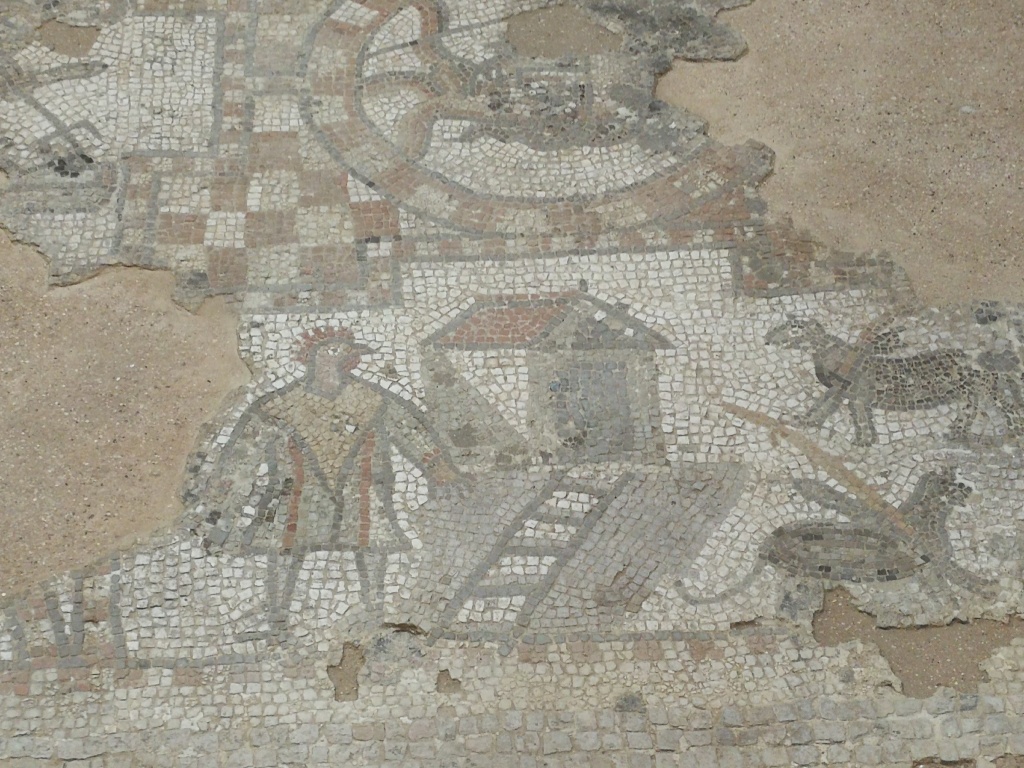On another day out from Sandown, S and I headed for Brading Roman Villa. It is not known who owned the villa, but the size of it, the presence of a bath house and underfloor heating as well as luxury goods found there suggest they would have been a wealthy and important person. The villa was built in the mid first century AD, shortly after the Roman conquest of southern England. There were many extensions and improvements over the following 400 years before it fell into decline. Now a couple of miles inland, in Roman times the villa had direct access to the sea via the Brading Haven estuary, which silted up in mediaeval times and was later drained. This sea access would have come in handy for trading with the British mainland and continental Europe. The remains of the villa are now housed within a modern visitors’ centre.
On our visit, we learned that there was significant trade between the Isle of Wight and elsewhere in Europe, even before the Romans arrived. Finds at the villa include wine and olive oil containers from France and Spain, drinking vessels from Germany and pottery from southern England. Building materials appear to have been sourced from Dorset, nearby on the mainland. At the villa, there is evidence of wheat and barley production, animal husbandry and fishing.
Monetary finds include silver coins minted by the rebel Emperor Alectus from 296 AD. Alectus had a short-lived reign in charge of an independent Britain before Roman Emperor Constantius reasserted his authority. It is thought that the villa’s owner would have been a supporter of Alectus and Brading Haven a base for the rebel fleet. The villa was confiscated when Alectus was overthrown.
Perhaps the most impressive finds at Brading are the mosaic floors, some of the best preserved in the region. 5 of the villa’s rooms have mosaics and designs include geometric patterns, the gods Orpheus and Bacchus, a cockerel headed man as well as agricultural and fishing themes.



There were 2 other buildings onsite including a farmhouse with a well and a granary. The latter does not survive today. Click here for a full video tour of the site by Friends of Brading Roman Villa.
After exploring the remains, S and I retired to the site café where I had a delicious jacket potato. I can’t remember what S had and neither can she, but there were no complaints.
After lunch we drove to the nearby town of Bembridge where we had an ice cream and walked along the seafront. From here, there were views of sailing boats on the Solent, between the Isle and the mainland. It was a pleasant little stroll, although there wasn’t too much to detain us.

We drove up to Culver Down, from where there are panoramic views north and south, and the Culver Haven Inn could quench our first. At first, the views south were no more than about 30 metres as the landscape was shrouded in cloud. Eventually, we caught a glimpse of Sandown Bay. S wasn’t too keen to linger up on the Down as we were very much exposed to the wind, which we hadn’t noticed at sea level.
Back at our apartment in Sandown, the gloom had lifted enough to see this view towards Shanklin.

Our daughter F and her friend had such a busy day doing something or other that they had worked up an appetite. It was time for a trip to the chip shop for tea.
Factfile:
Location
Brading is on the east side of the Isle of Wight, about 2 miles from Sandown. Bembridge is 4 miles to the north-east. The Isle of Wight is just off the south coast of England
Transport
Brading has a railway station just over 1 mile from the Roman Villa. There are regular train services from Sandown, Shanklin and Ryde, the latter connecting with the passenger ferry from Portsmouth on the mainland. Portsmouth has direct train services from London Waterloo (1h38mins), Cardiff (3h20mins) and Bristol (2h30mins). Vehicle ferries run from Portsmouth – Fishbourne and Southampton – East Cowes
Further information
Click the links for more information on the Isle of Wight and Brading Roman Villa

A very good blogging friend lives on the Isle of Wight and I’m sure she’ll know these well. Thanks for sharing 🤗🩵
LikeLiked by 1 person
You’re welcome 😊
LikeLiked by 1 person